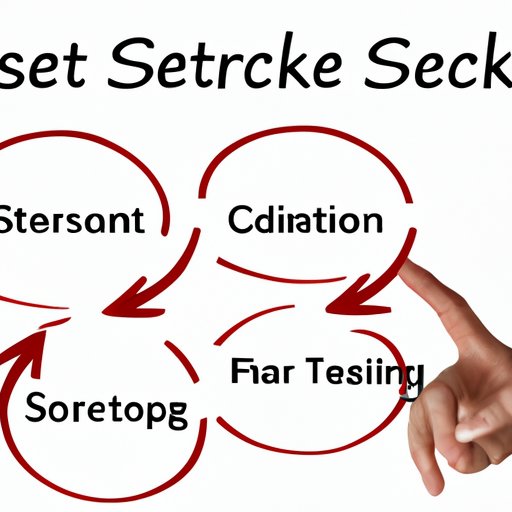
Introduction
Stroke is a serious medical condition that requires immediate attention. It can cause various symptoms that can last anywhere from a few minutes to a few weeks or even months. Understanding how long stroke symptoms last is crucial for timely treatment and successful recovery. In this article, we’ll explore the various types of stroke, the most common symptoms, factors that impact stroke duration, rehabilitation after stroke, real-life stories, latest research findings and tips for managing stroke symptoms. This article is aimed towards anyone interested in learning about stroke duration and recovery.
Overview of Stroke Symptoms
Stroke is a medical condition that occurs when there is a disturbance in blood flow to the brain. There are two main types of stroke – ischemic and hemorrhagic. Ischemic strokes are the most common type and occur when a blood clot blocks a blood vessel in the brain. Hemorrhagic strokes occur when a blood vessel in the brain ruptures.
The most common symptoms of stroke include sudden numbness or weakness in the face, arm, or leg, confusion or difficulty speaking, trouble seeing in one or both eyes, difficulty walking, loss of balance or coordination, and severe headache. Depending on the type of stroke, the duration of symptoms can vary significantly. Typically, symptoms of a transient ischemic attack (TIA), also known as a mini-stroke, can last anywhere from a few minutes to a few hours. In contrast, symptoms of a major stroke can last for several months or even years.
It’s important to note that different types of stroke can have different symptoms that can vary in duration. For example, people who have a hemorrhagic stroke may experience severe headaches that last for several days or weeks. Those who have an ischemic stroke may experience weakness or paralysis that lasts for several months or longer.
Factors Affecting Stroke Symptoms Duration
Several factors can influence how long stroke symptoms last. Firstly, the severity of the stroke can impact the duration of symptoms. Those who experience a mild stroke may recover more quickly than those who experience a severe one. Secondly, the type of treatment received can impact the duration of symptoms. People who are eligible for clot-busting drugs may recover more quickly than those who do not receive them. Lastly, other health factors such as age, overall health, and any pre-existing medical conditions can also impact how long it takes to recover from a stroke.
Recovery and Rehabilitation After Stroke
Rehabilitation after stroke is crucial for successful recovery. The duration of symptoms can vary depending on the severity of the stroke and the type of treatment received. However, in general, the majority of stroke recovery happens within the first 6 months after the stroke. During this period, rehabilitation therapy can help people regain functional independence and improve their quality of life.
Seeking treatment early is critical for maximizing the potential for recovery after a stroke. Treatment may include medications, surgery, or rehabilitation therapy such as occupational therapy, physical therapy, speech therapy or cognitive therapy. Rehabilitation therapy can help people regain their strength, mobility and communication skills, and prevent further complications associated with stroke.
Real-Life Stories
Real-life stories offer insight into the experience of individuals who have experienced a stroke. These stories can help people understand the challenges of stroke recovery and the importance of seeking treatment early. For example, the story of Margaret, who had a TIA, but did not seek medical attention for several days, highlights the importance of seeking immediate medical attention and treatment. Alternatively, the story of Robert, who followed through with rehabilitation therapy after his major stroke, shows the positive impact of post-stroke rehabilitation.
Latest Research on Stroke Symptoms
The latest medical research on stroke symptoms sheds light on the most effective treatment and rehabilitation strategies. Recent studies indicate that early rehabilitation therapy can lead to better outcomes for people after stroke. Additionally, other studies have focused on new approaches to stroke rehabilitation, such as virtual reality therapy, as means of promoting recovery.
Tips for Managing Stroke Symptoms
There are many ways to manage stroke symptoms and aid in recovery. Some tips include making lifestyle changes such as quitting smoking, getting regular physical activity, and eating a healthy diet. It’s also important to take medications as prescribed and follow through with recommended rehabilitation therapy. Staying engaged with friends and family and getting involved in community activities can also help improve mental health during the recovery process.
Conclusion
Stroke duration and recovery depend on the type and severity of the stroke, the type of treatment received, and other health factors. Understanding these factors is crucial for successful recovery after a stroke. Rehabilitation therapy is highly effective and can help people recover their functional independence and improve their quality of life. Seeking treatment early and following through with rehabilitation plans is critical for the best possible outcomes. Talk to your healthcare provider if you have concerns about stroke symptoms and their duration.




